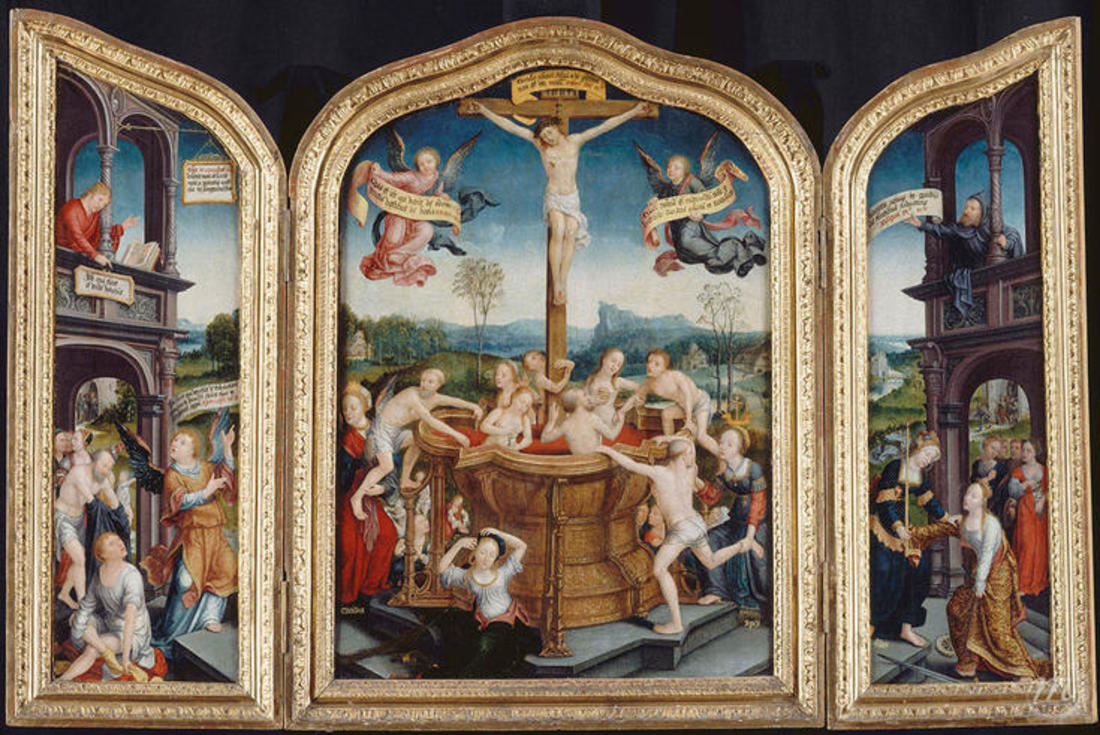The central panel of this triptych brings together several legends. This vat evokes the fountain of life, or the fountain of youth, which grants immortality to all those who drink its water. But here, the water has been replaced with blood! This is the blood that Christ lost during the Crucifixion for man's salvation.
All the characters in this painting come together to bathe there. Some are anonymous, while others can be identified by the objects associated with them. In the bath, we see Mary Magdalene and her vase, as well as Mary of Egypt, holding the three loaves that allowed her to survive in the desert. On the right-hand panel, a woman is represented with a wheel and sword at her feet. This is Saint Catherine, and the instruments of her martyrdom.
Three female characters can also be recognised. On either side of the bath stand Hope, with a boat atop her head, and Charity, with a sun. On the right, Faith carries a lit candle. These are the three theological virtues, guiding men in their relationship with God. Here, they guide them towards the redemptive blood.
The reverse of triptych panels traditionally present the person or people having commissioned the work. Here, two angels hold the coat of arms of Anchin Abbey, near Douai, and that of its abbot, Charles Coguin. What is special about this abbey is that it held a relic of the blood of Christ. The artist has therefore addressed the theme of the mystical bath upon the request of his commissioner.
Detail:
The Latin inscriptions, written on the scrolls of parchment, are extracts from the Bible evoking the souls of the followers saved by Jesus Christ's sacrifice.

The central panel of this triptych brings together several legends. This vat evokes the fountain of life, or the fountain of youth, which grants immortality to all those who drink its water. But here, the water has been replaced with blood! This is the blood that Christ lost during the Crucifixion for man's salvation.
All the characters in this painting come together to bathe there. Some are anonymous, while others can be identified by the objects associated with them. In the bath, we see Mary Magdalene and her vase, as well as Mary of Egypt, holding the three loaves that allowed her to survive in the desert. On the right-hand panel, a woman is represented with a wheel and sword at her feet. This is Saint Catherine, and the instruments of her martyrdom.
Three female characters can also be recognised. On either side of the bath stand Hope, with a boat atop her head, and Charity, with a sun. On the right, Faith carries a lit candle. These are the three theological virtues, guiding men in their relationship with God. Here, they guide them towards the redemptive blood.
The reverse of triptych panels traditionally present the person or people having commissioned the work. Here, two angels hold the coat of arms of Anchin Abbey, near Douai, and that of its abbot, Charles Coguin. What is special about this abbey is that it held a relic of the blood of Christ. The artist has therefore addressed the theme of the mystical bath upon the request of his commissioner.
Detail:
The Latin inscriptions, written on the scrolls of parchment, are extracts from the Bible evoking the souls of the followers saved by Jesus Christ's sacrifice.